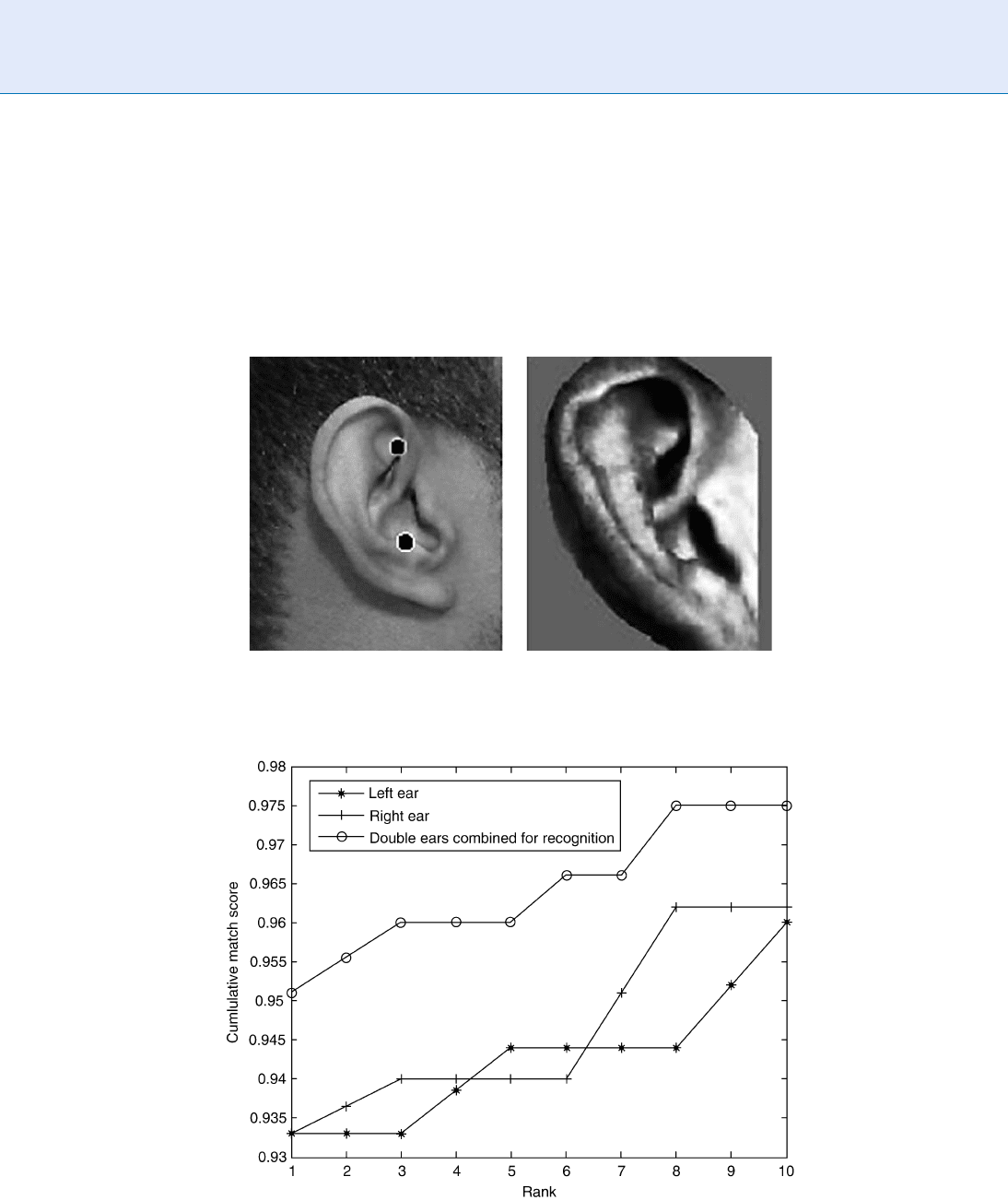Li S.Z., Jain A.K. (eds.) Encyclopedia of Biometrics
Подождите немного. Документ загружается.


1985 (i.e., bar code type output). The analogy with
fingerprint should be avoided, and the term DNA
profiling suggested by Evett & Buckleton preferred.
Indeed, the term profile indicates that this type of
analysis does not allow characterizing a person’s
DNA, but only given parts called markers. An explicit
mention of the markers and the technique used should
always accompany a given DNA profile.
▶ Forensic DNA Evidence
DNA Profiling
▶ Forensic DNA Evidence
DNA Typing
▶ Forensic DNA Evidence
Dolicocephalic
Dolicocephalic is the head form characterized by an
anteroposteriorly long and mediolaterally narrow
skull.
▶ Anatomy of Face
Double Angle Representation
It refers to doubling the angles of the gradients making
them fit to represent ridge directions continuously.
▶ Fingerprint Features
Double Dipping
Double dipping refers to the unethical act of seeking
compensation, benefits, or privileges from one or more
sources, given only a single legitimate entitlement. In
the context of biometrics, double dipping usually occurs
when an individual seeks such unauthorized advantage
and/or gain by assuming multiple nominal identities.
▶ Fraud Reduction, Applications
Drive-up
▶ Iris on the Move™
Duplicate Detection
▶ Fraud Reduction, Applications
Dynamic Programming Comparison
Method
Method of mathematical programming developed by
Richard Bellman (Dynamic Programming, Princeton
University Press, 1957).
It is useful in obtaining the optimal strategy when
the objective function to be maximized is monotonic
and recursively defined depending on a variable. In the
dynamic programming comparison method for signa-
ture recognition, dynamic programming is applied to
obtain the best warping function of the location vari-
able of the template against the location variable of the
questionable image , using the similarity between the
questionable image and the template as the objective
function.
▶ Signature Recognition
230
D
DNA Profiling

Dynamic Time Warping (DTW)
The DTW is a method used in text-dependent Speaker
Recognition. In this context, the training or testing
data are composed by a sequence of acoustic vectors
and the temporal order of the vectors is important. In
order to compute likelihood or a distance between two
of such sequences, two functions are needed, a frame to
frame distance function and a frame mapping func-
tion, able to align the individual acoustic frames of
both sequences. This time alignment function is man-
datory as two occurrences of the same linguistic mes-
sages, pronounced or not by the same speaker, present
different time characteristics, like the g lobal pronunci-
ation speed. If there is a training template T
r
with N
T
R
frames and a test utterance T
E
consisting in a sequence
of N
T
E
frames, the DTW is able to find the time
mapping function w(n) between T
R
and T
E
. In the
figure 1, the tying function w(n) is illustrated by the
tying of the T
R
frame at time x with the T
E
frame at
time y. Thus, the system can evaluate a distance D()
between T
R
and T
E
, defined by the following formula:
DT
R
T
E
¼
1
N
T
R
X
N
T
R
k¼1
dv
T
R
n
; v
T
E
wnðÞ
!
;
where, v
T
R
n
is a acoustic vector (cepstral vector) of the
training message TR at time n, v
T
R
wnðÞ
the time-aligned
acoustic vector of the test message TE and d() is the
frame to frame distance. The distance estimated in
Eq. 11 (thanks to DTW algorithm) is used to make
the decision of accepting or rejecting the claimed
identity.
▶ Signature Matching
▶ Speaker Matching
Dynamic Time Warping (DTW)
D
231
D


E
Ear Biometrics
MIC HAŁ CHORAS
´
Institute of Telecommunications University of
Technology and Life Sciences,
Bydgoszcz, Poland
Synonym
Ear Recognition
Introduction
Biometrics identification methods have proved to be
very efficient, more natural and easy for users than
traditional methods of human identification. Biometrics
methods truly identify humans, not keys and cards they
posses or passwords they should remember. The future
of biometrics leads to systems based on image analysis as
the data acquisition is very simple and requires only
cameras, scanners or sensors. More importantly, such
methods could be
▶ passive, which means that the
subject does not have to take active part in the whole
process or, in fact, would not even know that the pro-
cess of identification takes place. There are many pos-
sible data sources for human identification systems,
but the physiological biometrics has many advan tages
over methods based on human behavior. The most
interesting human anatomical parts for passive, physi-
ological biometrics systems are face and ear.
There are many advantages of using the ear as a
source of data for human identification. Firstly, the
ear has a very rich structure of characteristic ear parts.
The location of these characteristic elements, their direc-
tion, angles, size and relation within the ear are distinc-
tive and unique for humans, and therefore, may be used
as a modality for human identification [1, 2].
Ear is one of the most stable human anatomical
feature. It does not change considerably during human
life while face changes more significantly with age than
any other part of human body [1, 2]. Face can also
change due to cosmetics, facial hair and hair styling.
Second ly, human faces change due to emotions and ex-
press different states of mind like sadness, happiness, fear
or surprise. In contrast, ear features ar e fix ed and un-
changeable by emotions. The ear is not symmetrical – the
left and right ears are not the same. Due to forensics
and medical studies, from the age of 4 ears grow
proportionally, which is the problem of scaling
in computer vision systems [1].
Furthermore, the ear is a human sensor, therefore
it is usually visible to enable good hearing. In the
process of acquisition, in contrast to face identification
systems, ear images cannot be disturbed by glasses,
beard or make-up. However, occlusion by hair or earr-
ings is possible.
It is also important that ear biometrics is highly
accepted biometrics by users in possible access control
applications and government security such as visa/pass-
port programs. According to users, ear biometrics is less
stressful than fingerprinting. Moreover, users admitted
that they would feel less comfortable while taking part in
face images enrolment (people tend to care how they
look on photographs) [3]. Furthermore, in ear bio-
metrics systems there is no need to touc h any devices
and therefore there are no problems with hygiene.
It is worth mentioning that ear images are more
secure than face images, mainly because it is very
difficult to asso ciate ear image with a given person
(in fact, most of users are not able to recognize their
own ear image). Therefore, ear image databases do not
have to be as much secured as face databases, since the
risk of attacks is much lower.
On the other hand, ear biometrics is not a natural
way of identi fying humans. In real life we do not look
at people ears to recognize them. Our identification
decision is rather based on faces, voice or gait. The
reason is that people lack in vocabulary to describe
ears. The main task of ear biometrics is to define
such vocabulary – in context of the computer vision
#
2009 Springer Science+Business Media, LLC

systems, such vocabulary is called ‘‘features.’’ In ear
biometrics computer vision systems, the main task is
to extract such features, that will describe human ears
in a distinctive way.
Even though ear biometrics have not been imple-
mented commercially so far, there are already many
methods of feature extraction from ear images devel-
oped. In this paper our goal is to overview these app-
roaches and methods. The summary of the research
groups with the proposed approaches and methods is
given in the Table 1.
2D Ear Biometrics
In this section various approaches to 2D ear biometrics
are presented. Firstly, methods based on geometrical
parameters are overviewed. Then the global approach
to feature extraction from 2D ear images is sur veyed.
Geometrical Approach to Feature
Extraction
The first to explore the possibility of using ear as a
biometric in a computer vision system were Bur ge and
Burger [4, 5]. They presented the geometrical method
based on building neighborhood graphs and Voronoi
diagrams of the detected edges.
Additionally, Burge and Burger pointed out that
▶ thermal imaging may solve the problem of ear
occlusion (mainly by hair). They proposed to use
segmentation algorithm based on color and texture
of ear thermogram (ear thermal image).
Choras
´
developed several methods of geometrical
feature extraction from ear images [6–8]. The pro-
posed ‘‘Geometrical Parameters Methods’’ had been
motivated by actual procedures used in the police
and forensic evidence search applications. In reality,
procedures of handling ear evidence (earprints and/or
ear photographs) are based on geometrical features
such as size, width, height and earlobe topology [1].
Choras
´
developed and tested the following meth-
ods in order to extract distinctive geometrical features
from human ear 2D images:
Concentric circles based method – CCM
Contour tracing method – CTM
Angle-based contour representation method – ABM
Triangle ratio method – GPMTRM
Shape ratio method – GPMSRM
Moreover, in Choras
´
work the contour detection algo-
rithm and the method of ear contour image processing
in order to select the most meaningful contours have
been developed. Ear pre-classification method based
on the longest contour orientation have also been
proposed.
Choras
´
’ methods were tested in laboratory-
conditions. His ear image database was created in the
controlled environment. The most effective method s
were GPM and CTM. The Receiver Operating Charac-
teristic curves for each of the geom etrical method are
presented in Fig. 1.
Yuan and Tian presented ear contour detection
algorithm based on local approach [9]. Edge Tracking
is applied to three regions in which contours were
extracted in order to obtain clear, connected and
non-disturbed contour, which may be further used in
the recognition step.
Global Approach to Feature Extraction
Hereby, the g lobal approaches to feature extraction
from 2D ear images are presented. Principal Com-
ponent An alysis, Force Field Transformations and
Ear Biometrics. Table 1 Feature extraction approaches
for ear biometrics
Research group Proposed methodology
Burge and Burger 2D – Voronoi Diagrams
Choras
´
2D – Geometrical Methods
Hurley et al. 2D – Force Field
Transformation
Victor et al. 2D – PCA
Lu et al. 2D – ASM
Moreno et al. 2D – Compression Networks
Sana et al. 2D – Haar Wavelets
Yuan and Mu 2D – ASM
Arbab-Zavar 2D – SIFT, model
Chen and Bhanu 3D – ICP and shape
descriptors
Yan and Bowyer 3D – ICP, edge-based and
PCA
Cadavid and Abdel-
Mottaleb
3D – SFM, SFS
234
E
Ear Biometrics

Wavelets have been applied to ear biometrics human
identification. Recently, the idea of recognition based
on ear models gained some popularity and attention.
Victor et al. used Principal Component Analysis
(PCA) in the experiment comparing ear and face
properties in order to successfully identify humans in
various conditions [10, 11].
In case of faces, the authors perform recognition on
the basis of eigen faces. In case of ear biometrics, the
authors used a set of eigenears. Their work proved
that ear images are a very suitable source of data for
identification and their results for ear images were
not significantly different from those achieved for face
images.
The proposed methodology, however, was not
fully automated, since the reference (so called
landmarkpoints) had to be manually inserted into
images. In case of ear images these landmark points
are manually marked in the Triangular Fossa and in the
point known as Antitragus.
The sample ear image with the marked landmark
points and the corresponding eigenear vector are
shown in Fig. 2.
Hurley et al. introduced a method based on energy
features of the 2D image [12, 13]. They proposed to
perform force field transformation (step 1) in order to
find energy lines, channels and wells (step 2).
Moreno et al. presented another approach to ear
image feature extraction [14]. Their work was based on
macrofeatures extracted by compression networks.
Several neural networks method s a nd classifiers based
on 2D intensity images were presented:
Compression Networks,
Borda Combination,
Bayesian,
Weighted Bayesian Combination.
The best results of 93% were achieved by the Compres-
sion Network ear identification method.
Sana et al. developed a new approach to ear
biometrics based on Haar wavelets [15]. After ear detec-
tion step , Haar Wavelet Transformation is applied and
wavelet coefficients are computed. They performed their
experiments on two ear datasets (from Indian Institute of
Technology Kanpur and from Saugor Univ ersity) and
report accuracy of about 96% on both databases.
Ear Biometrics. Figure 1 The Receiver Operating Characteristic (ROC) curve describing CCM, ABM, CTM and GPM
methods (from left to right) [8].
Ear Biometrics
E
235
E

Lu et al. used Active Shape Models ( ASM) to model
the shape and local appearances of the ear in a statistical
form [16]. Then Eigenears have been also used in a final
classification step. They used both left and right ear
images and showed that their fusion outperforms results
achieved for single ears separately. They achieved 95.1%
recognition rate for double ears. Their results for left,
right and combined ears are presented in Fig. 3.
Yuan and Mu also explored the advantages of im-
proved Active Shap e Models (ASM ) to the task of ear
recognition [17]. They applied their algorithm to
the rotation-invariance experiment. The interesting
contribution of their work is the comparison of right
and left rotation of the same ears. They fou nd out that
right head rotation of 20 degree is acceptable for rec-
ognition. For left head rotation, the acceptable angle is
Ear Biometrics. Figure 2 Ear image with the manually marked landmark points (Triangular Fossa and Antitragus)
used in the PCA-based ear recognition [10].
Ear Biometrics. Figure 3 Cumulative Matching Score Curve for left, right and combined ears achieved by Lu
et al. [16].
236
E
Ear Biometrics

10 degree. Ear recognition results for different degrees
of head rotations are presented in Fig. 4.
Arbab-Zavar et al. proposed to use Scale Invariant
Feature Transform (SIFT) to extract the ear salient
points and to create human ear model later used in
recognition (Fig. 5)[18].
Their ear model is constructed using a stochastic
method. In their experiments they proved that using
ear model outperforms PCA method in case of occlud-
ed ears. The results of ear recognition for occluded ears
(40% from top, and 40% from left) in comparison to
PCA are given in Fig. 6.
Ear Biometrics. Figure 4 Ear recognition for different degrees of left and right head rotations [ 17].
Ear Biometrics
E
237
E

3D Ear Recognition
Recently, the possibility of human identification on the
basis of 3D images have been extensively researched.
Various approaches towards multimodal 2D+3D ear
biometrics as well as 3D ear biometrics, mainly based
on ICP (Iterative Closest Point), have been recently
developed and published [19–21, 23].
Chen and Bhanu proposed 3D ear recognition
based on local shape descriptor as well as two-step
ICP algorithm [19]. Additionally, they developed the
algorithm to detect ear regions from 3D range images.
They collected their own ear image database (UCR
database) consisting of 902 images from 302 subjects.
Their results of ear detection, matching and identifica-
tion are close to 100% recognition rate [20 ].
Yan and Bowyer developed three approaches to
3D ear recognition problem: edge-based, ICP and
3DPCA. Moreover they tested various approaches
(for example 2Dþ3D) in multimodal biometric
scenario [22].
They designed fully automated ear recognition sys-
tem and achieved satisfactory results of 97.6% Rank-1
recognition [23]. The ear recognition performance re-
sults drawn as Receiver Operating Characteristic Curve
and Cumulative Matching Score Curve are presented
in Fig. 7 [23 ].
In their research they did not exclude partially oc-
cluded ears or ears with earrings. They performed
experiments on the largest ear database collected so far.
UND ear database is now becoming a standard ear
database for ear recognition experiments. It is available
for free at: www.nd.edu%/7Ecvrl/UNDBiometrics-
Database.html.
Cadavid and Abdel-Mottaleb built 3D ear models
from captured video frames. Then they used ‘‘structure
from motion’’ (SFM) and ‘‘shape from shading’’ (SFS)
techniques to extract 3D ear characteristics [24]. They
were first to explore the 3D ear biometrics based on
video sequences, not on images acquired by 3D range
scanners.
Conclusion
Human ear is a perfect source of data for passive
person identification in many applications. In a grow-
ing need for security in various public places, ear
biometrics seems to be a good solution, since ears are
visible and their images can be easily taken, even with-
out the examined person’s knowledge.
The article presented an overview of various
approaches and solutions to a problem of feature extrac-
tion from ear images. The summary of the research
groups with the proposed approaches and methods is
given in the Table 1.
It is noticeable that even though all of the proposed
techniques are developed to solve the same image
processing task, many totally different methodologies
and algorithms have been developed.
Such situation proves that ear biometrics has lately
gained much interest and popularity in computer sci-
ence community. It also may be the indication that ear
biometrics will become one of a standard means of
human identification in unimodal or hybrid biometrics
systems.
Ear biometrics can also be used to enhance effec-
tiveness of other well-kn own biometrics, by its imple-
mentation in multimodal systems. Sin ce most of the
methods have some drawbacks, the idea of building
multimodal (hybrid) biomet rics systems is gaining lot
of attention [25]. Due to its advantages, ear biometrics
seems to be a good choice to support well known
methods like voice, hand, palm or face identification.
Ear Biometrics. Figure 5 Detected ear SIFT
keypoints [18].
238
E
Ear Biometrics

Summary
In this pap er the holistic overview of ear recognition
methods for biometrics applications is presented. 2D
and 3D image processing algorithms applied to ear
feature extraction are surveyed. Even though ear
biometrics have not be en implemented commercially
so far, as pointed out by Hurley et al. ear biometrics is
no longer in its infancy and has shown encouraging
progress [26]. In this work strong motivation for using
the ear as a biometrics is given, and afterwards, the
geometrical approach to 2D ear biometrics , the global
approach to 2D ear biometrics and 3D ear biometrics
methods are presented, respectively.
Related Entries
▶ Ear Biometrics, 3D
▶ Physical Analogies for Ear Recognition
Ear Biometrics. Figure 6 Ear recognition rates for occluded ear images, 40 % from top and 40% from left, respectively [18].
Ear Biometrics
E
239
E
